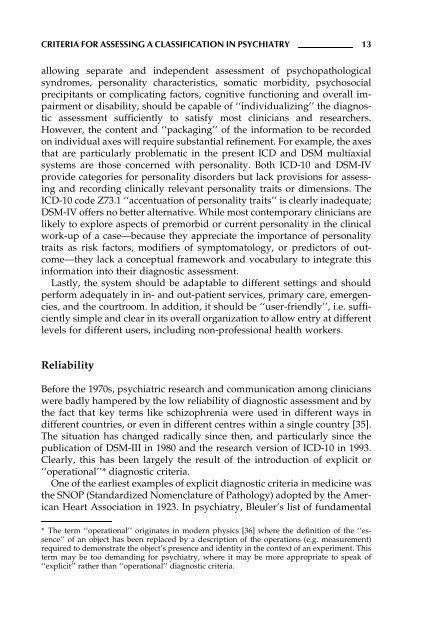Psychiatric Diagnosis and Classification - ResearchGate
Psychiatric Diagnosis and Classification - ResearchGate
Psychiatric Diagnosis and Classification - ResearchGate
Create successful ePaper yourself
Turn your PDF publications into a flip-book with our unique Google optimized e-Paper software.
CRITERIA FOR ASSESSING A CLASSIFICATION IN PSYCHIATRY 13<br />
allowing separate <strong>and</strong> independent assessment of psychopathological<br />
syndromes, personality characteristics, somatic morbidity, psychosocial<br />
precipitants or complicating factors, cognitive functioning <strong>and</strong> overall impairment<br />
or disability, should be capable of ``individualizing'' the diagnostic<br />
assessment sufficiently to satisfy most clinicians <strong>and</strong> researchers.<br />
However, the content <strong>and</strong> ``packaging'' of the information to be recorded<br />
on individual axes will require substantial refinement. For example, the axes<br />
that are particularly problematic in the present ICD <strong>and</strong> DSM multiaxial<br />
systems are those concerned with personality. Both ICD-10 <strong>and</strong> DSM-IV<br />
provide categories for personality disorders but lack provisions for assessing<br />
<strong>and</strong> recording clinically relevant personality traits or dimensions. The<br />
ICD-10 code Z73.1 ``accentuation of personality traits'' is clearly inadequate;<br />
DSM-IV offers no better alternative. While most contemporary clinicians are<br />
likely to explore aspects of premorbid or current personality in the clinical<br />
work-up of a caseÐbecause they appreciate the importance of personality<br />
traits as risk factors, modifiers of symptomatology, or predictors of outcomeÐthey<br />
lack a conceptual framework <strong>and</strong> vocabulary to integrate this<br />
information into their diagnostic assessment.<br />
Lastly, the system should be adaptable to different settings <strong>and</strong> should<br />
perform adequately in in- <strong>and</strong> out-patient services, primary care, emergencies,<br />
<strong>and</strong> the courtroom. In addition, it should be ``user-friendly'', i.e. sufficiently<br />
simple <strong>and</strong> clear in its overall organization to allow entry at different<br />
levels for different users, including non-professional health workers.<br />
Reliability<br />
Before the 1970s, psychiatric research <strong>and</strong> communication among clinicians<br />
were badly hampered by the low reliability of diagnostic assessment <strong>and</strong> by<br />
the fact that key terms like schizophrenia were used in different ways in<br />
different countries, or even in different centres within a single country [35].<br />
The situation has changed radically since then, <strong>and</strong> particularly since the<br />
publication of DSM-III in 1980 <strong>and</strong> the research version of ICD-10 in 1993.<br />
Clearly, this has been largely the result of the introduction of explicit or<br />
``operational''* diagnostic criteria.<br />
One of the earliest examples of explicit diagnostic criteria in medicine was<br />
the SNOP St<strong>and</strong>ardized Nomenclature of Pathology) adopted by the American<br />
Heart Association in 1923. In psychiatry, Bleuler's list of fundamental<br />
* The term ``operational'' originates in modern physics [36] where the definition of the ``essence''<br />
of an object has been replaced by a description of the operations e.g. measurement)<br />
required to demonstrate the object's presence <strong>and</strong> identity in the context of an experiment. This<br />
term may be too dem<strong>and</strong>ing for psychiatry, where it may be more appropriate to speak of<br />
``explicit'' rather than ``operational'' diagnostic criteria.

















